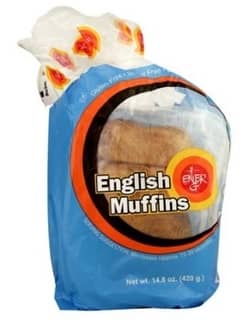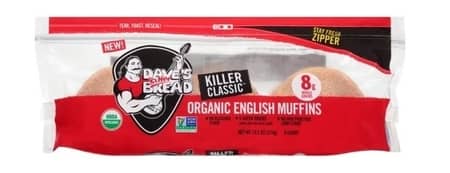This is a great question. Anytime a food product has a unique texture, you have to wonder how the texture is achieved, and whether or not any animal products need to be used to achieve it.
Are they vegan? Yes, English muffins are vegan by most standards. They often contain ambiguous ingredients (sometimes animal-derived) such as monoglycerides and enzymes, but most vegans don’t avoid such ingredients. And even the strictest of plant-based eaters can find English muffins without these additives.
Anyway, after a bit of research, I was surprised to find the above to be the case. In one of my first food science courses, I learned that the traditional English muffin recipe called for a number of animal ingredients.
Unlike other breads like loaf bread and bagels, English muffins are baked in a cornmeal-dusted, greased up pan or griddle. These delicious yeast breads, about 4 inches in diameter upon baking, are made by combining milk, flour, yeast, sugar, salt, and usually a good helping of butter.1
Fortunately, this is not the case anymore.
What we’ll do here is cover the more common ingredients, their function, and which ones are sometimes of animal origin.
Why English Muffins Are Generally Considered Vegan
English Muffins Are Made with Plant-Based Ingredients
Flours and Meals
- Cornmeal. My personal favorite ingredient. Cornmeal is used to achieve that nice gritty texture characteristic of English muffins. If an ultra-chewy texture is the hallmark of the bagel, the use of cornmeal is the trait that really makes English muffins stand out from other bread products.
- Malted Barley Flour. This is sometimes part of an enriched flour blend.
- Rice Flour. A common substitute for regular wheat flour.
- Malted barley flour. Unsurprisingly, this flour is made from barley that is malted—malted just means barley that’s allowed to germinate). It’s useful for baking as it also contains active enzymes.
All good here.
Other Dry Ingredients
- Yeast
- Wheat gluten—gluten just holds it together and keeps it from crumbling.
- Salt
- Sugar
Vinegar
Often grain or wine vinegar, or simply acetic acid. Vinegar is common in baked goods, as an acid in batters to react with sodium bicarbonate (baking soda) starting the chemical reactions that are needed to produce CO2 which gives the batters a nice lift as they bake.
No problems here.
English Muffins Are Made with Vegan-Friendly Additives
Preservatives
Vitamin Fortification
Micronutrients are used to boost nutritional profile, and in some cases, to act as preservatives—many have antioxidant properties.
These are usually okay as they’re usually minerals (extracted from the earth) or vitamins produced via chemical or microbial synthesis.2
Examples of vegan-appropriate micronutrients often found in bagels include:4
- Reduced iron
- Thiamin mononitrate (B1)
- Riboflavin (B2)
- Niacin (B3)
- Folic acid (B9)
Calcium Propionate and Potassium Sorbate
Calcium propionate and potassium sorbate are commonly used.
Calcium propionate is a preservative widely used in bread and other baked goods.3
Potassium sorbate is a preservative that’s used to inhibit the growth of molds and yeasts in many foods including baked goods.4
Citric Acid
Then, there’s citric acid. As discussed in the hummus article, citric acid is an organic acid, fortunately for vegans, naturally occurs in citrus fruits.
It’s among the strongest edible organic acids, so it’s ideal for food products. It’s typically used as a preservative or for flavoring.
Most production involves A. niger cultures fed on sucrose or glucose to produce citric acid directly. The sugar usually comes from molasses, or hydrolyzed corn starch, or corn steep liquor.6
Wheat Starch
This is a common ingredient and it’s perfectly vegan-friendly. Wheat starch is a very fine, white powdery substance used for baking. It’s mostly used as a thickener, though it’s also known to improve the texture of certain foods.
Potentially Non-Vegan Ingredients in English Muffins
The the ingredients discussed so far are completely non-controversial. But, some ingredients and additives have less consensus in the vegan community. What may be considered vegan to one vegan, may not be considered suitable to the next.
So, we’ll touch on these ingredients here.
Xanthan Gum
Xanthan gum is a carbohydrate with a ton of industrial uses, one of which being a food additive. It’s a favorite for use as a stabilizer (prevents ingredients from separating) and thickening agent a lot like guar gum. I wrote an article on guar gum you can check out here.
It’s produced by fermentation by Xanthomonas campestris often with simple sugars like glucose and sucrose.7
But, can be derived from whey protein from milk because some species can grow on lactose.8 Like monoglycerides, it’s a bit of a grey area and products containing it are still considered vegan by most.
Emulsifiers
Common emulsifiers used in English muffins and other baked goods include lecithin, mono-, and diglycerides.
These compounds help disperse fat ingredients evenly throughout the flour mixture. This helps trap gases, helping create a more evenly textured product.9 Both plants and animals can be used to derive emulsifiers.
Lecithin
This one’s very common. Lecithin is just the generic term for any group of yellow-brownish fatty substances that occur naturally in plant and animal tissues where they attract both water and fatty substances helping them to mix.10,11
This stuff can be derived from egg but tends to be sourced from soy. At least, in my experience of scanning labels. Especially, in baked goods. Soybean oil is often used as it’s a safe, cheap source. Safe, because as it happens, soy lecithin doesn’t contain enough of the allergenic proteins found in soy for most allergic folks to react to it.12
Monoglycerides
You’ve probably heard of triglycerides—the stuff that fills up our fat cells. Monoglycerides just have one fatty acid bound to glycerol instead of three as in TGs.13
In bakery food products, monoglycerides are used to improve loaf texture and volume, and they also serve as anti-staling agents.14,15
Industrially, the production of this compound is mostly achieved reacting triglycerides with glycerol.16
The problem is that the raw materials used for this reaction can be sourced from vegetables or animal fats.
These are problematic for some because there’s really no way of knowing where they came from unless the manufacturer of the food product states it on the label—which some do.
As I discussed in the article on bagels, the presence of this compound doesn’t disqualify the food product for all vegans. It’s just a personal choice.
For this reason, I listed a range of brands to choose from, so that you can use the level of restriction you feel comfortable with.
English Muffins Advertised/Endorsed as Vegan
Endorsed as Vegan
PETA wrote an article endorsing these.17
Trader Joe’s British Muffins
Both original and multigrain.
Food For Life English Muffins

All flavor varieties.
Ener-G English Muffins

Rudi’s Organic Bakery English Muffins

All flavors
Advertised as Vegan: Dave’s Killer Bread English Muffins

They say on their site that the only non-vegan bread product they produce is the Honey & Flax variety.18
So, that does it for English Muffins. Until next time.
References
- Understanding Food: Principles and Preparation (Page 430-31). Amy Brown – Wadsworth Cengage Learning – 2011
- Jose L. Revuelta, Ruben M. Buey, Rodrigo Ledesma‐Amaro, and Erick J. Microbial biotechnology for the synthesis of (pro)vitamins, biopigments, and antioxidants: challenges and opportunities. Microb Biotechnol. 2016 Sep; 9(5): 564–567.
- Codex Alimentarius data for calcium propanoate Archived 2006-10-21 at the Wayback Machine
- Erich Lück, Martin Jager and Nico Raczek “Sorbic Acid” in Ullmann’s Encyclopedia of Industrial Chemistry, Wiley-VCH, Weinheim, 2000.doi:10.1002/14356007.a24_507
- –
- Lotfy, Walid A.; Ghanem, Khaled M.; El-Helow, Ehab R. (2007). “Citric acid production by a novel Aspergillus niger isolate: II. Optimization of process parameters through statistical experimental designs”. Bioresource Technology. 98 (18): 3470–3477. doi:10.1016/j.biortech.2006.11.032
- EFSA Panel on Food Additives and Nutrient Sources (14 July 2017). “Re‐evaluation of xanthan gum (E 415) as a food additive”. EFSA Journal. European Food Safety Authority. 15 (2): e04909. doi:10.2903/j.efsa.2017.4909. Retrieved 1 March 2019.
- Tortora, G.J., Funke, B.R., & Case, C.L. (2010). Microbiology: An Introduction, 10th edition. San Francisco: Benjamin Cummings. Pg. 801.
- Understanding Food: Principles and Preparation (Page 383). Amy Brown – Wadsworth Cengage Learning – 2011
- “Lecithin”. Merriam Webster Dictionary Online.
- Szuha, Bernard F. “Chapter 7”. Lecithins: Sources, Manufacture & Uses. The American Oil Chemist’s Society. p. 109. ISBN 0-935315-27-6.
- “Soy Lecithin”. Food Allergy Research and Resource Program. University of Nebraska–Lincoln. Retrieved 14 December 2018.
- IUPAC, Compendium of Chemical Terminology, 2nd ed. (the “Gold Book”) (1997). Online corrected version: (2006–) “glycerides”
- Y. H. Hui (15 February 2008). Bakery Products: Science and Technology. John Wiley & Sons. pp. 350–. ISBN 978-0-470-27632-7.
- Gerard L. Hasenhuettl; Richard W. Hartel (1 January 1997). Food Emulsifiers and Their Applications. Springer. ISBN 978-0-412-07621-3.
- Sonntag, Norman O. V. (1982). “Glycerolysis of fats and methyl esters — Status, review, and critique”. Journal of the American Oil Chemists’ Society. 59 (10): 795A–802A. doi:10.1007/BF02634442. ISSN 0003-021X
- These Vegan Bagel And Cream Cheese Brands Will Make Your Day https://www.peta.org/living/food/vegan-bagels-cream-cheese/
- Frequently Asked Questions http://www.daveskillerbread.com/faq

